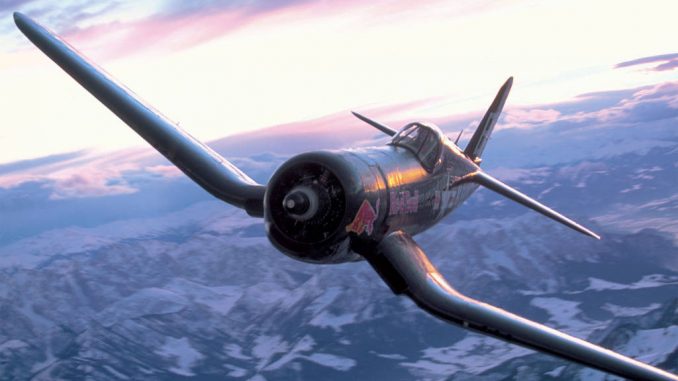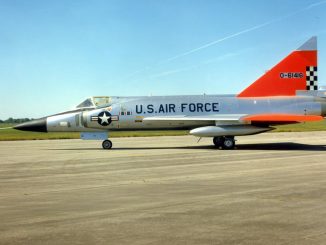
The Vought F4U Corsair was an American fighter and carrier-based bomber aircraft designed and manufactured by Chance Vought. The Corsair gained popularity soon after its introduction and received several additional production contracts from Goodyear and Brewster, who re-designated their Corsairs as FG (Goodyear) and F3A (Brewster). Production started in February 1938, after the U.S. Navy Bureau of Aeronautics published two request proposals for twin-engine and single-engine fighters. The single-engine fighter was requested to have a minimum stall speed not higher than 70 mph and a range of 1000 miles. The fighter’s armament was requested to carry four guns, or three with increased ammunition. Later in June, the U.S. Navy signed a contract with Vought for a prototype and the manufacturing began under the supervision of Rex Beisel.

Technical Specifications
The prototype was designated XF4U-1 and became the first airframe ever designed from scratch to have a Double Wasp engine equipped for flight. The final manufacturing result was the biggest and most powerful engine along with the largest propeller and the largest wing on any naval fighter. It incorporated the largest engine of the time and to make it even sturdier, the F4U was also equipped with a massive 13-foot propeller (a Hamilton Standard Hydromatic three-blade propeller). The XF4U-1 took its first flight on May 29, 1940, with Lyman A. Bullard and an expedited landing was made when the elevator trim tabs failed. The seatbacks observed during the flight were rectified and this low-wing monoplane was soon popularized for its inverted gull appearance and large fuselage. The fuselage panels were composed of aluminum and the outer wings, main spar, armament bays, ailerons, elevators and rudders featured fabric as their skinning. The Corsairs was the last American-produced fighter aircraft to showcase a skinning fabric.
General Specifications
| Type | Carrier-Based Fighter Bomber |
| Manufacturer | Chance Vought |
| Engine | 1 × Pratt & Whitney R-2800-18W radial engine, 2,380 hp |
| Weight | |
| Empty | 9,205 lb |
| Maximum Take-off | 14,533 lb |
Dimensions
| Wingspan | 12.50 m |
| Length | 10.26 m |
| Height | 4.50 m |
Performance
| Maximum Speed | 446 mph |
| Service Ceiling | 41,500 ft |
| Range | 873 nm |

Top Vought F4U Corsair Milestones
The prototype XF4U-1 became the first single-engine U.S. fighter to fly faster than 400 mph by flying at an average speed of 405 mph from Stratford to Hartford on October 1, 1940. The aerodynamic capabilities of the Corsair also made the FSU-1 considerably faster than the Grumman F6F Hellcat and only 13 mph slower than the Republic P-47 Thunderbolt. Moreover, the F4U was the first U.S. Navy aircraft to be equipped with a landing gear that retracted into a fully enclosed wheel well. The Corsair saw its first combat on February 14, 1943, while escorting a formation of Consolidated B-24 Liberators on a raid against a Japanese aerodrome at Kahili under Major Gise. The VMF-124 later produced the first Corsair ace, as the Corsair units started getting an upper hand.
War Kills
Second Lieutenant Kenneth A. Walsh racked up a total of 21 kills during the war with his Corsair Ace. The F4U recorded many aerial victories during its operational period including an unusual kill scored by Marine Lieutenant R. R. Klingman of VMF-312 over Okinawa. Kingman’s guns jammed due to the thickening of gun lubrication from extreme cold while chasing a Japanese twin-engine aircraft at a high altitude. He still succeeded in chopping off the enemy’s tail with the large propeller of his Corsair. This maneuver lost him five inches on his propeller blade, but he managed to land safely and was awarded the Navy Cross for it. The Corsair also served in the Korean War and Lieutenant Thomas J. Hudner, Jr was also awarded a Medal of Honor for a crash landing in his F4U-4 of VF-32 in an attempt to rescue his squadron mate, Jesse L. Brown. Unfortunately, Brown, the U.S. Navy’s first African American naval aviator, did not survive the incident.

Final Days
The F4U not only served the U.S. and the British but also the Royal New Zealand Air Force, French Naval Aviation, and other air forces until the 1960s. The last Corsair to be manufactured was the F4U-7, which was specifically built for the Aeronavale (French naval air arm). A total of 12,571 F4U Corsairs were built along with 16 separate models between 1940 and 1953. The Corsairs flew their last combat missions in 1969 during the Football War between Honduras and El Salvador and were in service with both air forces. After the French Naval Service retired their F4U-7s in 1964, many were sold to private owners in the United States, maintained in airworthy condition, and were used in several film projects.The Corsairs gained many popular nicknames during its service like the “The Sweetheart of the Marianas,” “The Angel of Okinawa,” “Ensign Eliminator,” and “Bent-Wing Eliminator.” It was also sometimes called “U-bird” or “Bent Wing Bird” based on its appearance. Another alleged Allied World War II sources nicknamed the aircraft “Whistling Death,” although Japanese sources do not support this, and it was mainly known as the Sikorsky. After the war, five F2G aircraft were sold as surplus and found success in air racing, marked by their “Race” numbers. They achieved notable victories in the Thompson Trophy races, winning in both 1947 and 1949. Today, only two F2G-1s remain, identified by BuNos 88454 and 88458 (Race 57). The sole surviving F2G-2, BuNo 88463 (Race 74), unfortunately was destroyed in a crash in September 2012, just over a year after a full restoration was completed in July 2011. Additionally, an FG-1D Corsair is displayed in the In Harm’s Way: Pacific exhibit at the National Museum of the U.S. Navy, symbolizing resilience and strength.
Related Articles
"Haritima Maurya, pen name, ""Another Stardust,"" has been passionate about writing since her school days and later began sharing her work online in 2019. She was drawn to writing because of her love for reading, being starstruck by the art of expression and how someone can make you see and feel things exclusive to their experience. She wanted to be able to do that herself and share her mind with world cause she believes while we co exist in this beautiful world least we can do is share our little worlds within.
As a commercial pilot, Haritima balances her passion for aviation with her love for storytelling. She believes that, much like flying, writing offers a perspective beyond the ordinary, offering a bridge between individual experiences and collective understanding.
Through her work, ""Another Stardust"" aims to capture the nuances of life, giving voice to moments that resonate universally. "









There were THREE F2G-1 survivors. Two operating as racers, one in static display. Only one racer was destroyed.